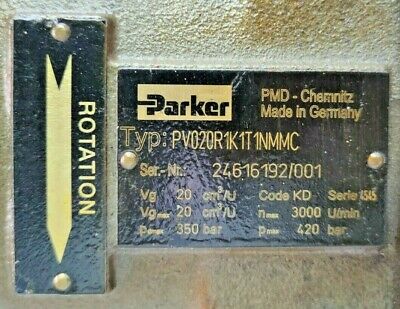The Parker Hydraulic Pump is a vital component in engineering applications, playing a crucial role in achieving optimal performance. With its remarkable capabilities and reliability, the pump has become synonymous with engineering excellence in motion. This article provides a comprehensive overview of the Parker Hydraulic Pump, exploring its key features, working principle, and applications across various industries. Additionally, it delves into the advantages of using this pump, including enhanced efficiency, cost-effectiveness, and environmental sustainability. By understanding the factors influencing its optimal performance and learning effective maintenance techniques, engineers can maximize the pump’s lifespan and ensure uninterrupted productivity.
Understanding Parker Hydraulic Pump
The Parker Hydraulic Pump encompasses a range of key features and components that make it an indispensable tool in numerous engineering applications. At its core, the pump operates on the principle of converting mechanical power into hydraulic energy, enabling the transmission of force through pressurized fluid. This mechanism allows for precise and controlled movement in various industrial systems.
The pump consists of essential components such as an inlet, outlet ports, pistons or gears, and a reservoir. These components work in tandem to facilitate the seamless flow of hydraulic fluid, generating the required force for different applications. The pump’s design ensures optimal efficiency, reliability, and longevity.
With its versatility, the Parker Hydraulic Pump finds application in diverse industries, including manufacturing, construction, agriculture, and aerospace. It powers hydraulic systems in machinery such as cranes, excavators, loaders, presses, and aircraft landing gear, among others. The pump’s ability to handle heavy loads, operate in extreme conditions, and deliver consistent performance makes it an ideal choice for demanding engineering environments.
In the next section, we will explore the advantages of utilizing the Parker Hydraulic Pump in engineering applications, further highlighting its significance in achieving optimal performance.

Advantages of Parker Hydraulic Pump
The Parker Hydraulic Pump offers numerous advantages that make it a preferred choice in engineering applications. By harnessing its capabilities, engineers can unlock enhanced performance, cost-effectiveness, and environmental sustainability in their systems.
One of the primary advantages of the Parker Hydraulic Pump is its efficiency and reliability. The pump is designed to minimize energy loss and maximize output, ensuring optimal performance in hydraulic systems. Its robust construction and precision engineering contribute to its reliability, enabling it to withstand high pressures, heavy loads, and challenging operating conditions with minimal downtime.
Furthermore, the Parker Hydraulic Pump enhances overall system performance and productivity. With its precise control over fluid flow and pressure, it enables smooth and efficient operation of hydraulic machinery. This translates into increased productivity, reduced cycle times, and improved output quality, ultimately leading to higher profitability for businesses.
Cost-effectiveness and long-term savings are additional benefits offered by the Parker Hydraulic Pump. Its efficient design and reliable performance minimize energy consumption, resulting in reduced operational costs. Moreover, the pump’s durability and longevity reduce the need for frequent repairs or replacements, saving both time and money in the long run.
In line with the growing focus on sustainability, the Parker Hydraulic Pump brings environmental benefits to engineering applications. Its efficient energy usage helps reduce carbon emissions and minimize the ecological footprint of hydraulic systems. Additionally, the pump’s reliable performance and extended lifespan contribute to resource conservation by minimizing waste generation.
In the subsequent section, we will delve into the factors that influence optimal performance when utilizing the Parker Hydraulic Pump, providing valuable insights for engineers and system operators.
Factors Influencing Optimal Performance
To achieve optimal performance with the Parker Hydraulic Pump, several factors come into play. Engineers and system operators need to consider these factors during installation, maintenance, and operation to ensure efficient and reliable performance of the pump.
Proper installation and maintenance techniques play a crucial role in maximizing the pump’s performance. It is essential to follow the manufacturer’s guidelines and specifications during installation, ensuring correct alignment, secure connections, and appropriate fluid levels. Regular maintenance, including inspections, cleaning, and lubrication, helps prevent issues such as leaks, component wear, or contamination, which can negatively impact the pump’s performance.
Compatibility with other hydraulic components is another significant factor to consider. Each component within a hydraulic system should be compatible with the Parker Hydraulic Pump in terms of pressure ratings, fluid compatibility, and operational requirements. Mismatched components can lead to inefficiencies, reduced performance, and potential system failures.

Choosing the right pump model for specific applications is critical. Engineers must consider factors such as flow rate, pressure requirements, and duty cycle to select the most suitable pump variant. Undersized or oversized pumps can result in inadequate performance, increased energy consumption, or premature wear and tear.
Regular monitoring and troubleshooting are vital to maintain optimal performance. Engineers should implement a comprehensive monitoring system to track the pump’s operating parameters, including pressure, temperature, and fluid levels. This allows for timely detection of potential issues, enabling prompt troubleshooting and preventive measures to avoid system failures.
By paying attention to these factors, engineers can ensure the Parker Hydraulic Pump operates at its best, delivering reliable and efficient performance in various engineering applications. In the next section, we will explore routine maintenance procedures, common troubleshooting techniques, and tips for maximizing the lifespan of the pump.
Maintenance and Troubleshooting Tips
To keep the Parker Hydraulic Pump operating at its peak performance, routine maintenance procedures and effective troubleshooting techniques are essential. By following these guidelines, engineers can maximize the pump’s lifespan and minimize potential issues.
Routine maintenance procedures for the Parker Hydraulic Pump include regular inspections, cleaning, and lubrication. Inspect the pump for any signs of leaks, worn-out seals, or damaged components. Clean the pump and its surrounding area to prevent the accumulation of dirt and debris that can affect performance. Proper lubrication of moving parts ensures smooth operation and reduces friction.
In case of common issues, effective troubleshooting techniques can be employed. If the pump experiences a drop in performance or inadequate fluid flow, check for clogged filters or blocked inlet ports. Clear any obstructions to restore proper flow. If there are abnormal noises or vibrations, inspect for loose fasteners or worn-out bearings. Tighten or replace components as necessary.
Timely repairs and replacements are crucial for maintaining optimal performance. If any component of the pump is damaged or worn beyond repair, it should be promptly replaced. Ignoring or delaying necessary repairs can lead to further damage and compromise the pump’s overall performance.
To maximize the lifespan of the Parker Hydraulic Pump, engineers should also consider the following tips. Avoid operating the pump at extreme temperatures or beyond its recommended pressure limits. Provide adequate ventilation and cooling to prevent overheating. Regularly monitor and change the hydraulic fluid to ensure proper lubrication and prevent contamination.
In conclusion, by adhering to routine maintenance procedures, implementing effective troubleshooting techniques, and following these tips, engineers can ensure the longevity and reliable performance of the Parker Hydraulic Pump.
Innovative Technologies and Upgrades
The Parker Hydraulic Pump continues to evolve with innovative features and technologies, paving the way for enhanced performance and increased efficiency. These advancements further improve the pump’s capabilities and offer additional benefits to engineering applications.

One notable innovation is the introduction of advanced digital monitoring and predictive maintenance features. With the integration of sensors and monitoring systems, engineers can gather real-time data on the pump’s operating parameters. This data enables proactive maintenance scheduling, allowing for timely inspections, lubrication, and component replacements. By identifying potential issues before they escalate, downtime can be minimized, and the pump’s performance can be optimized.
Integration with automation and control systems is another significant development. The Parker Hydraulic Pump can now be seamlessly integrated into automated processes, enabling precise control and synchronization with other machinery and systems. This integration enhances overall system efficiency, reduces human error, and optimizes productivity in various industries.
Upgrades in hydraulic pump technology have also led to improvements in energy efficiency and environmental sustainability. Advanced designs and materials minimize internal leakage, resulting in reduced energy losses and enhanced overall efficiency. Additionally, the use of eco-friendly hydraulic fluids and the implementation of smart energy management systems contribute to a greener and more sustainable operation.
Looking towards the future, ongoing research and development in hydraulic pump technology aim to further enhance performance and reliability. Innovations such as improved sealing mechanisms, optimized hydraulic circuit designs, and enhanced materials are expected to deliver even greater efficiency and durability.
In the next section, we will explore industry success stories and case studies that highlight the practical implementation of the Parker Hydraulic Pump and the benefits achieved by various companies.
Industry Success Stories and Case Studies
Real-world examples demonstrate the tangible benefits and success achieved by companies that have implemented the Parker Hydraulic Pump in their operations. These success stories showcase the pump’s capabilities and its impact on various industries.
In the manufacturing sector, a leading automotive company integrated the Parker Hydraulic Pump into their production line. By utilizing the pump’s precise control and reliable performance, they experienced a significant reduction in cycle times, resulting in increased production output and improved overall efficiency. This implementation led to cost savings, improved product quality, and enhanced customer satisfaction.
In the construction industry, a renowned construction equipment manufacturer incorporated the Parker Hydraulic Pump in their hydraulic systems. The pump’s robust construction and ability to handle high pressures allowed for the efficient operation of heavy machinery such as excavators and cranes. This resulted in improved productivity, reduced downtime, and increased profitability for both the manufacturer and their customers.
Case studies from the agricultural sector demonstrate the advantages of the Parker Hydraulic Pump in farm machinery. A large-scale agricultural operation implemented the pump in their irrigation systems, enabling precise control of water flow and distribution. This optimized water usage, reduced energy consumption, and enhanced crop yield, leading to significant cost savings and environmental sustainability.
These industry success stories, along with numerous others, highlight the quantifiable benefits and improvements achieved through the implementation of the Parker Hydraulic Pump. Whether it is increased productivity, cost-effectiveness, improved efficiency, or sustainability, the pump has consistently proven its value across a wide range of applications.
In the concluding section, we will recap the importance of achieving optimal performance with the Parker Hydraulic Pump and summarize the key factors that influence its performance.

Conclusion
In conclusion, achieving optimal performance with the Parker Hydraulic Pump is crucial for engineering excellence in motion. The pump’s remarkable features and components make it an indispensable tool in various applications across industries. By understanding its working principle, applications, and advantages, engineers can harness the pump’s capabilities to enhance performance, productivity, and cost-effectiveness.
Factors such as proper installation, maintenance techniques, compatibility with other components, and selecting the right pump model influence the pump’s performance. Regular monitoring and troubleshooting help identify potential issues and ensure uninterrupted operation. Adhering to routine maintenance procedures, employing effective troubleshooting techniques, and following maintenance tips are essential for maximizing the pump’s lifespan.
Innovative technologies and upgrades, such as digital monitoring, predictive maintenance, and integration with automation systems, further enhance the pump’s efficiency and functionality. Ongoing research and development in hydraulic pump technology promise even greater advancements in the future.
Real-world success stories and case studies highlight the tangible benefits achieved by companies implementing the Parker Hydraulic Pump. Increased productivity, cost-effectiveness, improved efficiency, and environmental sustainability are among the advantages experienced by various industries.
In closing, engineers and system operators are encouraged to explore the capabilities of the Parker Hydraulic Pump in different applications. By embracing engineering excellence in motion and leveraging the pump’s strengths, they can achieve optimal performance, unlock operational efficiencies, and drive success in their respective fields.
Related Keywords
# Parker F1 Pump pdf,
# Parker PVP pdf,
# Parker Valve,
# Parker gear pump,
# Parker Pump,
# Hydraulic Power Unit,
# Parker Filtration,
# Parker Motor,

